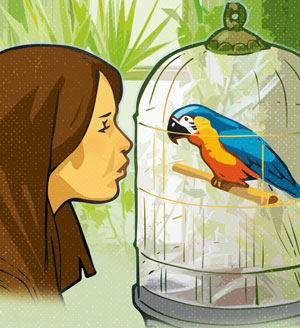By continuing your visit to this site, you accept the use of cookies.
Learn + I agreeThe risks

We know that the avian flu is transmitted to humans by sick birds.
However, did you know that animals often carry microbes that will not harm them, but are dangerous for our health?
How do animals transmit microbes to humans?
- Through scratches and bites : even clean and healthy cats may carry the Bartonella henselae or Pasteurella multocida bacteria and transmit them to us. Moreover, the Capnocytophaga canimorsus bacterium often lives in the muzzle of cats and dogs, and is dangerous for people with a weaker immune system1, such as small children, pregnant women, transplant patients, or patients undergoing chemotherapy.
- Through the air or the wind which can transport dust from animals, containing bacteria such as Coxiella burnetii or Chlamydia psittaci.
- Through the consumption of food stemming from contaminated animals, such as raw milk or eggs.


Some behaviors to avoid
Different activities will expose us to microbes responsible for zoonosis2. For example:
- Teasing or annoying a cat. It could bite or scratch to defend itself.
- Getting too close to sheep or goats, especially if the wind blows in your direction.
- Sleeping in a sheepfold or shearing sheep or goats without a protective mask.
- Surrounding yourself with many birds by feeding them for example.
- Standing really close to a bird or a reptile and kiss them.




In summary
In all our contacts with animals, whether they are in good or bad health, pets or exotic, we need to be reasonable and aware that there is always a slight risk that microbes dangerous for humans may be transmitted.
Arthropods3 such as fleas and ticks , may also transport diseases from the animal to humans. The deadly plague4 in the Middle Ages was caused by a specific bacterium (Yersinia pestis), which is passed from rats to humans via fleas. The plague still exists nowadays. It is endemic6 in certain regions in Africa and some outbreaks can sometimes occur. The island of Madagascar experienced an outbreak of plague in 2017 with over 200 casualties.
Immune system1 = Set of mechanisms (antibodies, white blood cells…) protecting us from infections.
Zoonosis2 = Infectious disease transmitted directly or indirectly to humans by animals.
Arthropod3 = Small animal with articulated legs and an external rigid skeleton, which forces it to evolve through successive molts. Over one million and a half different species of arthropods exist. It is the one animal group most present on earth. It includes insects, arachnids (spiders, scorpions and mites), shellfish, and Myriapoda (centipedes).
Plague4 = Disease caused by Yersinia pestis. Several rodent species may carry this bacterium, such as rats or squirrels. The fleas living on these rodents are infected by the bacterium and can transmit it to humans by biting them. Since the discovery of antibiotics5, the plague does no longer present a serious threat compared to the deadly epidemics of the past.
Antibiotic5 = A drug which allows to kill bacteria or at least to stop their growth. Antibiotics act against bacteria, but do not help treat diseases caused by viruses and parasites.
Endemic6 = Defines a disease which is present in a defined geographic area.
